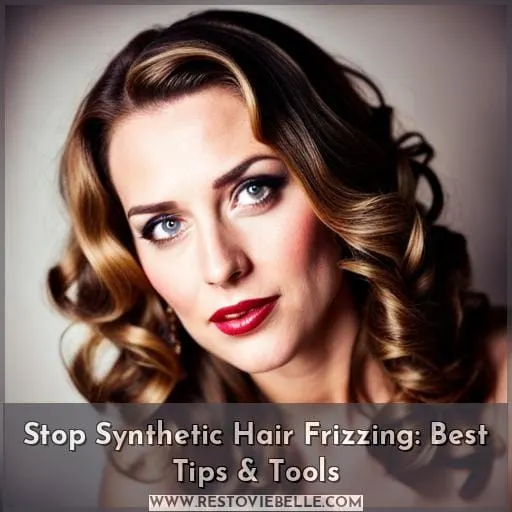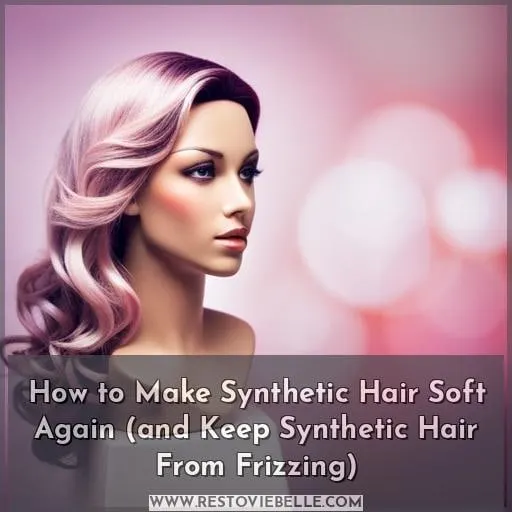This site is supported by our readers. We may earn a commission, at no cost to you, if you purchase through links.
 Are you looking for the best ways to stop synthetic hair frizzing? If so, you are in luck! We’ve compiled a list of tips and tools that will help keep your wig soft and free from static. From proper storage techniques to selecting the right products, we have everything covered.
Are you looking for the best ways to stop synthetic hair frizzing? If so, you are in luck! We’ve compiled a list of tips and tools that will help keep your wig soft and free from static. From proper storage techniques to selecting the right products, we have everything covered.
And with our helpful advice on how to differentiate between natural wigs and synthetic ones, it’s easier than ever before to make sure that you take great care of your wig – no matter which type it is.
So if you’re ready to get started on reducing or preventing frizz in your synthetic hair wig then read on!
Table Of Contents
- Key Takeaways
- Why Does a Synthetic Wig Become Frizzy?
- How to Make Synthetic Hair Soft Again (and Keep Synthetic Hair From Frizzing)
- What’s the Difference Between Synthetic and Natural Wigs?
- How Do You Defrizz Your Synthetic Wig?
- Must-Have Tool to Defrizz a Wig and Make a Wig Soft
- Frequently Asked Questions (FAQs)
- Conclusion
Key Takeaways
- Store wigs in temperature-controlled areas to prevent frizz.
- Use synthetic-specific shampoo and conditioner for washing.
- Use wig-specific detangling tools and apply leave-in conditioners before styling.
- Invest in quality wig care products and trim split ends carefully to manage flyaways.
Why Does a Synthetic Wig Become Frizzy?
Storing your synthetic wig properly, washing it regularly but not overusing shampoo and conditioner, as well as limiting the number of times you wash it, are all essential steps to preventing frizz. To keep your synthetic wig looking its best and minimize the risk of damage or excessive heat from styling tools, these simple habits can go a long way in maintaining a smooth texture for longer.
Proper Storage
Storing your synthetic wig properly is paramount to prevent pestering frizz, so pack it away with proper precautions:
- Keep the wig in a temperature-controlled area.
- Washing techniques and detangling tips help maintain its softness and shine.
- Heat styling should be done cautiously as heat has been known to cause extensive damage.
- The importance of regular care for wigs cannot be overstated; use specific products when washing and conditioning them for best results. Proper storage means less time spent on maintenance, resulting in a more manageable style that lasts longer!
Wash Your Wig
Washing your wig regularly is key to keeping frizz at bay. Use a synthetic-specific shampoo and conditioner that will help maintain the wig’s shape, texture, color, and heat control. It’s also important to pay attention to pH balance when washing your synthetic wigs as this helps prevent dryness and breakage of the fibers.
Utilize gentle brush techniques with leave-in conditioners while using a hot air brush for styling if desired. You can create waves or straighten hair with ease! Invest in quality wig care products specifically designed for protecting against frizzing during prolonged use.
These often include serum sprays as well as hydrating masks which can be used weekly along with a regular cleaning routine for maximum protection from dreaded frizz.
Keep up on maintenance by following proper storage instructions after each wash. Don’t forget about those pesky flyaways either!
Don’t Overuse
Avoid overusing styling products on your synthetic wig, as this can cause buildup that leads to frizz. Consider heat-proofing the hair with a leave-in conditioner and using only light oils or sprays for hold.
It’s important to limit wear when weather conditions are extreme. Apply care products sparingly before reapplying more if necessary after several hours of wear.
When it comes time to style, use low heat levels and keep away from hot rollers or flat irons unless your wig is expressly designed for such treatments.
Invest in quality hair care products specifically designed for wigs so you don’t have any surprises down the road!
Take off your wig at night, wash regularly with mild shampoo, and brush gently. All these steps help ensure beautiful locks without harsh frizziness!
Less Washing
Too much washing can strip away your synthetic wig’s natural oils, resulting in dryness and frizz. So, be sure to limit washes to once every two weeks for best results. Heat application should also be done with caution, as excessive heat can damage the wig fibers and cause breakage.
Detangling tools like wide-tooth combs or finger detangling are more suitable than brushes when dealing with synthetic hair. Leave-in conditioner is necessary for adding moisture back into the strands. Trimming tips, such as cutting split ends, may help manage some of the flyaways but should only be done by a professional stylist if possible.
For optimal care, use pH balanced products specifically designed for wigs that protect against weather effects, such as static electricity buildup and humidity-related frizzing!
How to Make Synthetic Hair Soft Again (and Keep Synthetic Hair From Frizzing)
Maintaining the softness and sheen of synthetic wigs can be challenging, especially in hotter climates. Fortunately, there are several methods for protecting your wig from frizz: washing correctly using wig-specific products, choosing appropriate detangling tools, applying heat sparingly with the right heating tools, and trimming judiciously to reduce excessive frizzing and tangling.
Wash the Wig Properly
Carefully washing your synthetic wig will help keep it from becoming frizzy and unruly. To ensure proper care, use cleaning methods customized to the type of wig you own. Detangling tips, such as using a wide-tooth comb for wigs, can be helpful when styling the hair after washing is complete.
Heat settings should also be taken into consideration during product use – opt for lower temperatures on all conditioning treatments or heat styling tools if possible! Finally, make sure that you are only using specialized wig care products designed specifically for synthetic wigs in order to get optimal results with minimal damage.
Choose the Right Detangling Tools
Choosing the right detangling tools is key to keeping your synthetic hair soft and free from frizz, although you may be tempted to just use a regular brush.
For best results, consider using a wide-tooth comb or specially designed wig brushes. Start off by setting your heat settings low and gradually increasing them as needed.
When detangling on a wig stand, make sure that the bristles are gentle enough not to cause snags in the fabric of your synthetic hairpiece.
And remember, general rules about preventive action apply here too – good habits go far when it comes to successful management of any kind of frizz prevention!
Choose the Right Products
Selecting the right products for your synthetic hair will help keep it soft and free from frizz. Wet brushing with a wide-tooth comb, gentle brushing with heat-resistant products, wig-specific shampoos, and conditioners are all important steps in maintaining its health.
Leave-in conditioners can provide extra protection against tangles and dryness. When using heat-friendly synthetics, flat ironing should be done on low to medium heat settings. Dryer sheets can be used to combat static electricity, as well as minimal frizz caused by friction or extended use of the wig during festivals or special events.
With proper care, you’ll enjoy beautiful synthetic tresses that stay smooth without any worry of damage or excessive frizz!
Use of Heating Tools
Heating tools, such as rollers and flat irons, can be used to achieve salon-worthy looks without sacrificing the softness of synthetic hair.
Cool water is also essential when washing wigs to prevent damage from high temperatures. A wig stand should be used for drying after a wash and before styling with heated products like a flat iron or curling wand for desired results.
Opting for heat-friendly wigs made specifically for use with these products will result in less hair breakage due to heat damage compared to regular synthetics, which may not hold up as well under extreme temperatures.
With proper care and usage of the right heating tools tailored towards synthetic materials, you’ll have great-looking styles that last!
Trim the Synthetic Hair
Trimming your synthetic hair can be a great way to manage frizz and tangles without risking damage.
- Clean your hair with wig-specific products.
- Apply heat carefully.
- Use leave-in conditioner regularly.
- Brush, style, and then dry using a hot air brush.
Knowing when trimming is necessary is key as it keeps your hairstyle looking fresh and prevents further split ends or excessive frizzing caused by prolonged use of styling tools. Be sure to research all cleaning techniques, heat application methods, and brushing techniques before taking any action on synthetic wigs.
What’s the Difference Between Synthetic and Natural Wigs?
Are you looking to purchase a wig and wondering what the difference is between synthetic and natural wigs? Synthetic hair has been designed to replicate human hair in look, feel, and texture while being heat-resistant.
However, it generally requires more maintenance than natural wigs due to its susceptibility to frizzing. It’s important that you understand what makes them different before deciding which type of wig is right for your needs.
Makeup of the Hair
Discovering the makeup of your synthetic wig is key to understanding how to stop it from frizzing. Synthetic hair is made up of individual strands that are designed and colored for a specific look, unlike natural hair, which can take on different textures and colors.
To properly care for synthetic wigs, you need specialized products tailored towards its unique needs. These range from daily shampoo treatments to styling tools such as heat protectant sprays or static solutions.
You may also want to consider investing in a good quality wig cap liner or top piece to help reduce wear-and-tear damage while providing additional volume and color options if desired.
With proper care techniques, like using milder detergents with cold water rinses alongside gentle detangling processes each time you wash your wig, you’ll be well on your way towards achieving softness and preventing further frizziness!
Heat-Resistance
Understanding the heat resistance of your synthetic wig is essential in managing frizz, as excessive temperature can cause irreparable damage. To protect against this, use heat-resistant products and styling tools when caring for your wig.
Consider trimming tips to keep it looking its best or a hot airbrush for hair rejuvenation and revitalization.
Maintenance
Proper maintenance of synthetic wigs is key to preventing frizz. For maximum drying power with 30% less frizz, use the Revlon One-Step Volumizer Teal. When cleaning and conditioning your hairpiece, use wig care products tailored toward synthetics.
Store it on a wig stand or mannequin head between uses and avoid heat tools if possible. Use detangling combs, leave-in conditioner sprays, and deep moisturizing treatments for long-lasting softness and shine while keeping flyaways at bay.
Additionally, make sure you regularly trim split ends and keep up with regular styling appointments.
How Do You Defrizz Your Synthetic Wig?
Maintaining a synthetic wig can be tricky, especially when it comes to managing frizz. To help keep your synthetic hair looking its best, there are several techniques that you should consider implementing, such as washing your wig regularly with the right products and using dryer sheets for static control.
Additionally, detangling with a wide-tooth comb is key for gentle care, as well as applying mild heat through flat ironing or steaming to address overall frizziness.
Washing Your Wig
Washing your wig correctly is key to keeping it looking and feeling its best, so make sure you follow the right steps. Use a synthetic-specific shampoo and conditioner for optimal results. Wash in cold water with gentle motions.
Apply heat application cautiously – use low temperatures with rollers or flat irons to remove frizz while avoiding damage. Utilize trimming tips carefully by seeking professional assistance before snipping away flyaways or dry ends for hair health preservation.
Implement care tips such as leave-in conditioners, detangling tools, and hot air brushes for reshaping wavy styles without excessive frizzing out of control. Regularly assess washing frequency alongside pH levels to ensure ultimate wig protection from environmental stressors like friction and humidity buildup.
Use Dryer Sheets
To prevent static and minimal frizz, try adding a dryer sheet to your synthetic wig – it’s like giving your hair a hug of protection! Opt for wig-specific products when possible. When brushing or styling, use gentle techniques and select the right tools. Trim sparingly as this may cause more damage than good.
Heat moderation is key: never exceed the temperature limit of synthetic wigs’ base material. Store tips include using low heat settings and drying on a flat surface with a moderate airflow setting from any heating tool used in conjunction with dryer sheets for maximum benefit.
Make sure to choose a quality product selection when shopping around as not all will help in addressing overall frizz.
Detangle Your Wig
Gently detangle your wig using a wide-tooth comb for softer, shinier hair. Deep condition regularly to repair damage and use heat-protective products to prevent further frizzing. Use conditioning spray before brushing and anti-frizz serum or cream after detangling synthetic wigs.
Choose the right wig care products as they differ from human hair treatments when it comes to ingredients and application instructions for optimal results in preventing frizz on synthetic hair.
Use Heat
Applying heat to your synthetic wig is an effective way to defrizz and keep it looking soft and shiny. Heat-resistant wigs are best for flat ironing, while products like dryer sheets can help reduce static electricity.
Additionally, regular washing with wig care products helps prevent frizz from accumulating in the long run. A handheld steamer or brush will aid in reshaping hair without damaging it. Leave-in conditioners should also be applied before styling if desired.
The key here is finding what works best for you. With patience comes success!
Must-Have Tool to Defrizz a Wig and Make a Wig Soft
When it comes to defrizzing a synthetic wig and making sure it stays soft, you need the right tools. The Revlon One-Step Volumizer Teal is an ideal choice for this task. This dryer and volumizer utilizes ionic and ceramic technology to reduce frizz by up to 30%.
Its unique oval brush design helps create volume, while its three heat/speed settings ensure minimal damage when styling your wig.
Additionally, using leave-in conditioners along with hot air brushes can help soften hair without causing excessive frizz or tangles. To further protect your wig against heat damage, look for products specifically designed for wigs that are labeled as heat resistant or choose brush styling techniques over flat irons if possible.
With proper detangling tools like wide-toothed combs combined with various softening techniques such as steaming or finger detangling, you can have beautiful-looking locks in no time!
Frequently Asked Questions (FAQs)
How should synthetic wigs be stored to prevent frizz?
Store synthetic wigs with care to prevent frizz! Use dryer sheets and a wig stand for maximum frizz-fighting power. Then, use mild heat tools like flat irons or hot air brushes to shape your style.
How often should synthetic wigs be washed?
To maintain softness and prevent frizz, synthetic wigs should be washed every 10-14 days—or more often during the summer. Utilize wig-specific products for optimal results, rinse with cool water, and allow to air dry on a stand.
Is it safe to use regular hair styling products on synthetic wigs?
It’s generally best to avoid using regular hair products on synthetic wigs. Instead, opt for wig-specific products designed to reduce frizz and tangles while preserving softness and shine. Avoid heat styling tools as much as possible – if needed, use a low setting with caution.
Are synthetic wigs more prone to frizz in humid climates?
Yes, synthetic wigs tend to be more prone to frizz in humid climates. To prevent it, use dryer sheets and a wide-tooth comb for gentle detangling. Apply mild flat iron heat or a handheld steamer if needed, then condition with leave-in products.
For styling, try using hot air brush tools – but always remember that low heat is best! Finally, trim the ends occasionally too for maximum control over flyaways and tangles.
Is it possible to repair damage caused by heat on synthetic wigs?
Yes, it is possible to repair heat-damaged synthetic wigs. For instance, try using a handheld steamer or flat iron on low heat settings and conditioner to help restore the wig’s softness and shine.
Conclusion
Looking to stop synthetic hair frizzing? It’s not impossible – in fact, the key to a frizz-free head of synthetic hair lies in understanding the root cause and taking preventive measures.
According to research, failing to properly care for a synthetic wig can lead to up to 40% more frizz. The Revlon One-Step Volumizer Teal is a great tool to help minimize frizz while providing volume and control.
To make your synthetic wig look its best, be sure to store it properly, wash it regularly with wig-specific products, and use mild heat tools at a low setting. There’s also the option of trimming your wig or using a hot air brush to achieve a soft, renewed look.
With the right care and maintenance, you can keep your synthetic wig looking and feeling its best!










